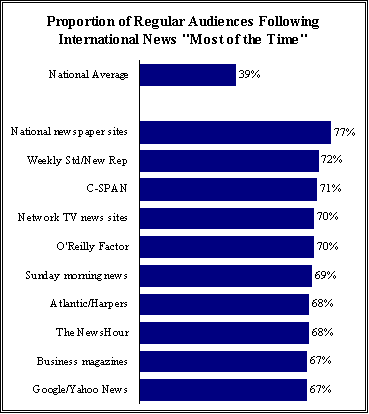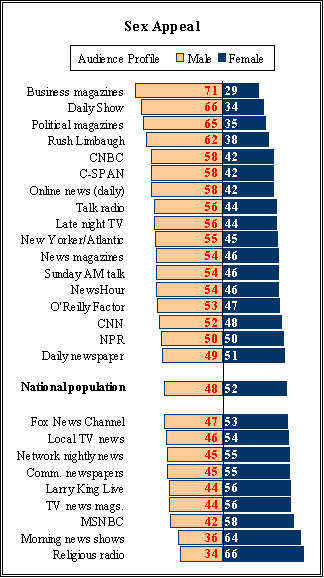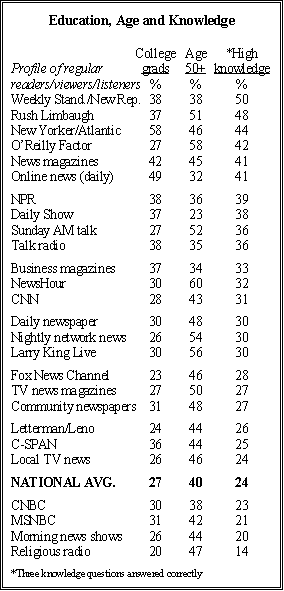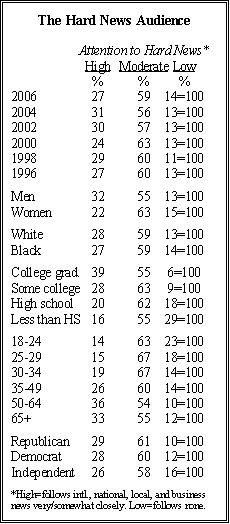 Majorities of Americans say they follow local news (57%) and national news (55%) most of the time, not just when important events occur. But the opposite is true for international news just 39% say they follow overseas news most of the time, compared with 58% who follow it only when something important happens.
Majorities of Americans say they follow local news (57%) and national news (55%) most of the time, not just when important events occur. But the opposite is true for international news just 39% say they follow overseas news most of the time, compared with 58% who follow it only when something important happens.
That represents a significant shift from 2004, when 52% said they followed international news most of the time. However, the current measure is consistent with findings from earlier news consumption surveys.
The spike in regular attention to foreign news in April 2004 came during a particularly tumultuous period in Iraq. Since then, interest in news from Iraq has fallen, as has the percentage saying they regularly track overseas news.
Notably, interest in foreign news has declined most among many of the same demographic and political groups that showed the biggest increases two years ago. The percentage of women saying they follow international news most of the time rose from 32% in 2002 to 51% in 2004; since then, it has fallen to 34%, which has led to a reopening of the gender gap on this measure.
Similarly, educational differences in the regular audience for international news have re-emerged. Half of college graduates say they follow overseas events most of the time, compared with a third of those with a high school education or less. And while regular interest in foreign news increased more among Republicans than Democrats or independents between 2002 and 2004, it also has fallen much more among Republicans since then.
Where Foreign News Consumers Go
 Several news outlets stand out for their success in attracting news consumers who follow international news most of the time, and not just when something important happens. The websites of major national newspapers such as USA Today.com, New York Times.com, and the Wall Street Journal online have especially large numbers of regular foreign news consumers. More than three-quarters (77%) of those regularly visiting such sites say they follow international news most of the time regardless of whether something important is happening.
Several news outlets stand out for their success in attracting news consumers who follow international news most of the time, and not just when something important happens. The websites of major national newspapers such as USA Today.com, New York Times.com, and the Wall Street Journal online have especially large numbers of regular foreign news consumers. More than three-quarters (77%) of those regularly visiting such sites say they follow international news most of the time regardless of whether something important is happening.
Other internet audiences disproportionately drawn to foreign news include those of network TV news sites such as CNN.com, ABCNews.com, and MSNBC.com (70%), as well as those who regularly visit websites such as Google News, AOL News, and Yahoo News (67%).
Among television news sources, C-SPAN (71%), Sunday morning interview programs (69%), the O’Reilly Factor (70%), and the NewsHour (68%) have especially large numbers of international news consumers. In the print media, political magazines such as the Weekly Standard and the New Republic (72%) and literary magazines such as The Atlantic, Harpers, and The New Yorker (68%) stand out for their high proportion of foreign news consumers. But so too do business magazines such as Fortune and Forbes (67%).
 Weather Tops News Interests
Weather Tops News Interests
The overall pattern of public news interest has remained fairly steady over the years, although there have been recent declines in interest in both news about international affairs and news about political figures and events in Washington, DC. Fully half of Americans say they track weather news very closely, by far the highest percentage for any subject listed.
The percentage who say they follow news about international affairs (17%) is now at its lowest point since 2000 (14%). Similarly, the percentage tracking political news very closely has fallen from 24% two years ago to 17%. The current measure is even a bit below the 21% recorded in 2002, the most recent midterm election.
The News Gender Gap
Men and women not only go to different places for news, but the topics they follow are often different as well. Men dominate the audience not only for sports news but also for news about science and technology, business and finance, and international affairs. More men than women are also found among those who closely follow news events and people in Washington, DC, as well as among those who say they pay close attention to news about local government.
But women greatly outnumber men among those who closely follow news about religion, health, and entertainment. They are also disproportionately represented among those paying close attention to community news and to news about culture and the arts. Men and women are about equally likely to be found among the audiences for crime, weather, and consumer news. The upshot of these differences is that men are significantly more likely to be regular consumers of “hard news” 32% vs. 22% for women. This orientation is reflected in their choices among different kinds of news media and in preferences among specific sources.
Men are significantly more likely than women to regularly turn to the internet, to radio news, talk radio, and to newspapers. By contrast, women are substantially more likely to regularly watch morning network news shows, and are somewhat more likely to turn to television news in a variety of forms.
 Looking at specific news outlets and sources, men significantly outnumber women in the regular audiences for business magazines, political magazines such as The Weekly Standard and New Republic, Rush Limbaugh’s radio program, and also the Daily Show with Jon Stewart. For each of these, men constitute more than 60% of the audience. Men are also significantly more numerous (at 58%) among the regular viewers of CNBC and C-SPAN and among daily internet news consumers. They are also disproportionately represented in the audience for talk radio, for literary and political magazines such as the Atlantic and New Yorker, and for late night television.
Looking at specific news outlets and sources, men significantly outnumber women in the regular audiences for business magazines, political magazines such as The Weekly Standard and New Republic, Rush Limbaugh’s radio program, and also the Daily Show with Jon Stewart. For each of these, men constitute more than 60% of the audience. Men are also significantly more numerous (at 58%) among the regular viewers of CNBC and C-SPAN and among daily internet news consumers. They are also disproportionately represented in the audience for talk radio, for literary and political magazines such as the Atlantic and New Yorker, and for late night television.
By contrast, women constitute a much larger share of the audience for religious radio (66% of the regular audience), the morning network television news shows (64%), and for the MSNBC cable channel. They also outnumber men among the regular audiences for TV news magazine shows such as Dateline and 60 Minutes, and for Larry King Live.
Knowledgeable News Audiences
News audiences vary widely in age, education, and how much they know about what’s going on in the nation and the world. Most regular consumers of news are better informed, better educated, and older than the average American. But the audiences for some news sources stand out in this respect.
 Judged by their answers to three news knowledge questions1, the most informed audiences belong to the political magazines, Rush Limbaugh’s radio show, the O’Reilly Factor, news magazines, and online news sources. Close behind are the regular audiences for NPR and the Daily Show.
Judged by their answers to three news knowledge questions1, the most informed audiences belong to the political magazines, Rush Limbaugh’s radio show, the O’Reilly Factor, news magazines, and online news sources. Close behind are the regular audiences for NPR and the Daily Show.
Audiences with the highest educational achievement, by far, are the literary magazines and online news outlets. Readers of news magazines, political magazines and business magazines, listeners of Rush Limbaugh and NPR, and viewers of the Daily Show, and C-SPAN also are much more likely than the average person to have a college degree.
Some of these attentive and educated audiences also are older than average. The oldest audiences belong to the NewsHour (60% age 50 or older), the O’Reilly Factor (58%), Larry King Live (56%), network nightly news (54%), and Sunday morning talk shows (52%). The youngest audience though also one of the most knowledgeable belongs to the Daily Show, where just 23% are age 50 or older and 33% are under age 30.
 After growing modestly between 2000 and 2004, the attentive audience for political, international, and business news commonly referred to as “hard news” is somewhat smaller in 2006. Currently, 27% of the public follows each of four kinds of stories, including news about political figures and events in Washington, international affairs, business and finance, and local government. Two years ago, this hard news audience accounted for 31% of the public. The decline was greater among Republicans (now 29%, down from 38% in 2004) than among other groups. Republicans and Democrats (28%) now exhibit similar enthusiasm for hard news.
After growing modestly between 2000 and 2004, the attentive audience for political, international, and business news commonly referred to as “hard news” is somewhat smaller in 2006. Currently, 27% of the public follows each of four kinds of stories, including news about political figures and events in Washington, international affairs, business and finance, and local government. Two years ago, this hard news audience accounted for 31% of the public. The decline was greater among Republicans (now 29%, down from 38% in 2004) than among other groups. Republicans and Democrats (28%) now exhibit similar enthusiasm for hard news.
The hard news audience is better educated and older than the average, though even among people with four year college degrees, fewer than a majority (39%) fall into this category. More men than women (32% vs. 22%) are hard news enthusiasts. There is no significant racial difference on this measure.


